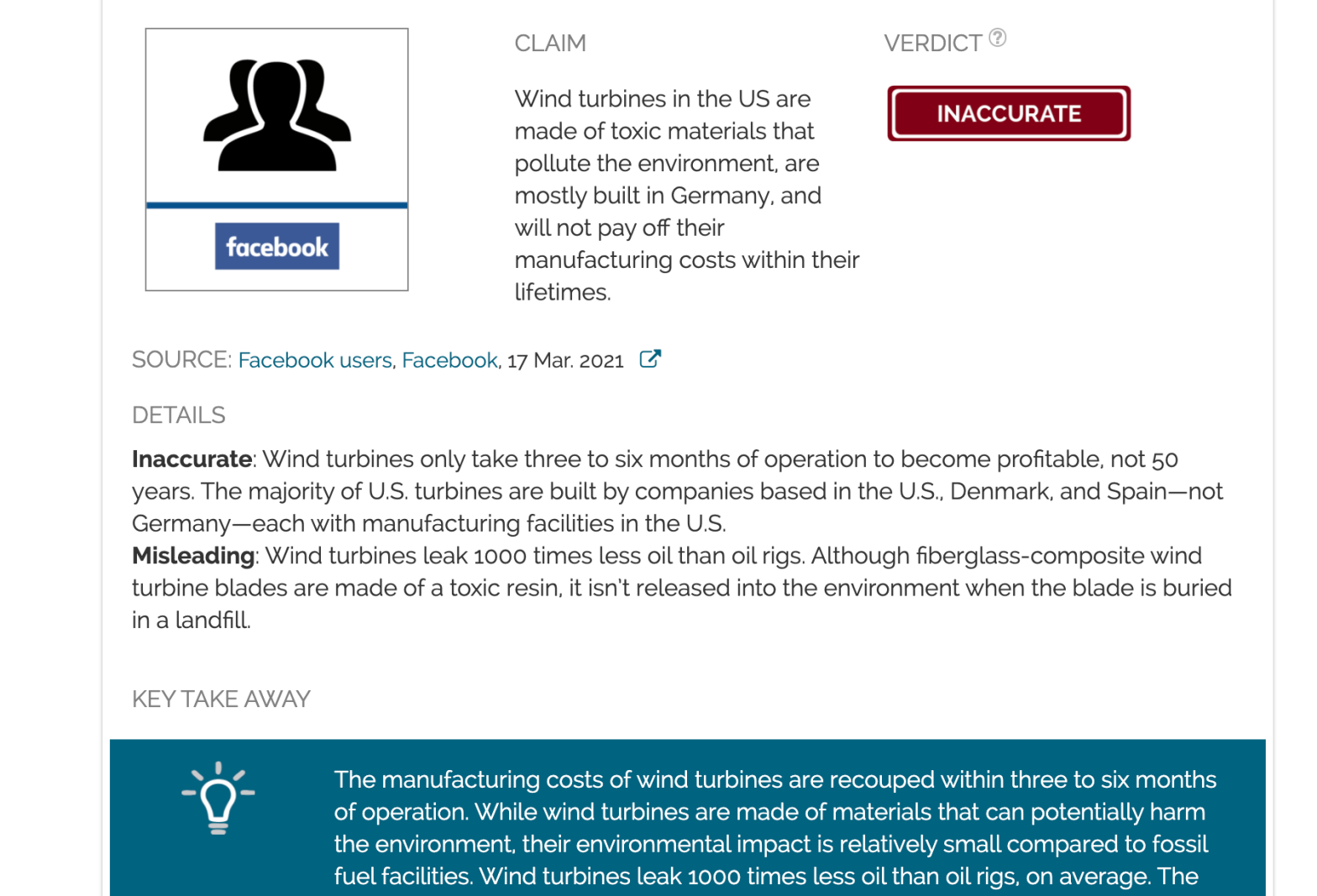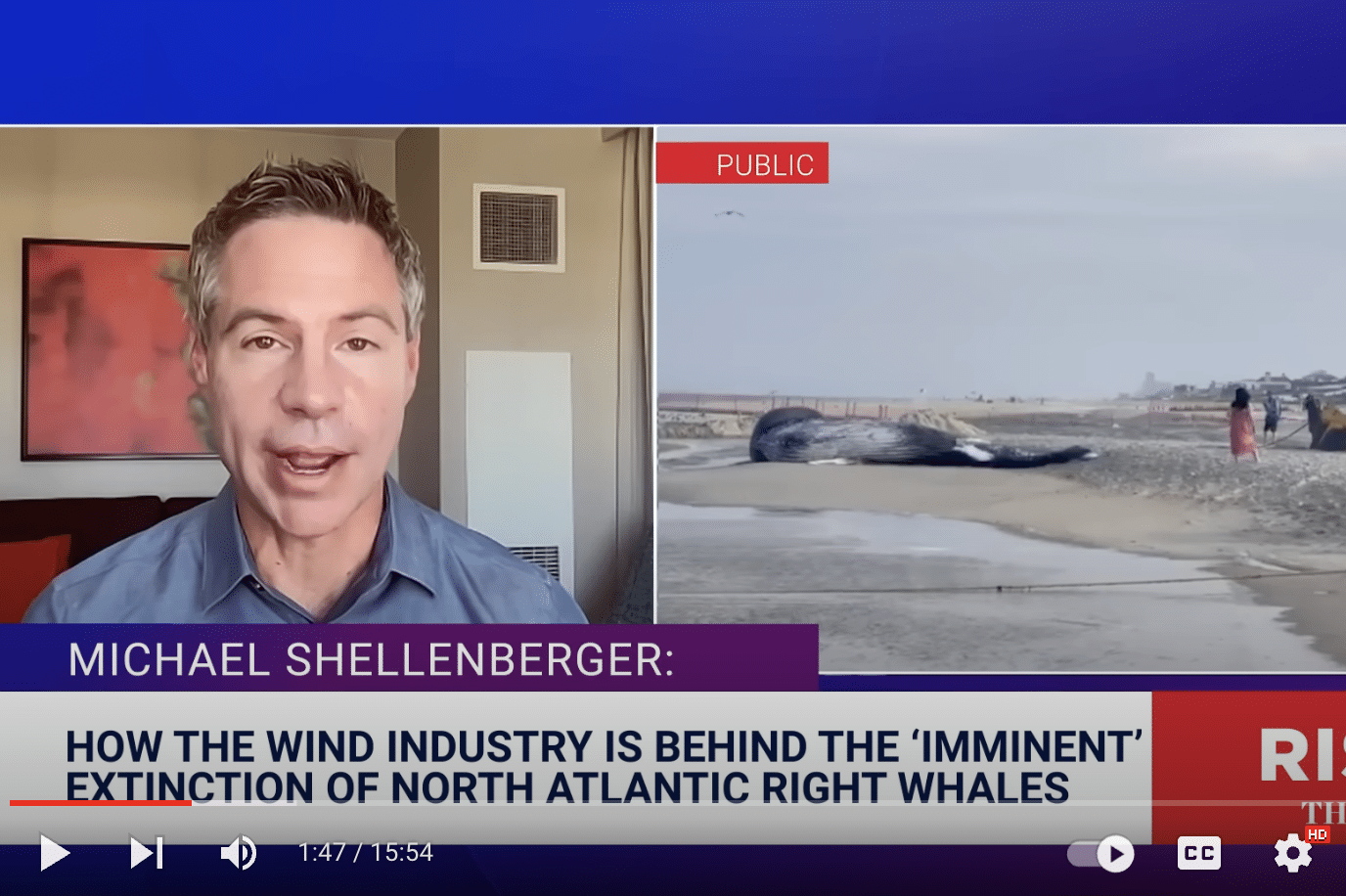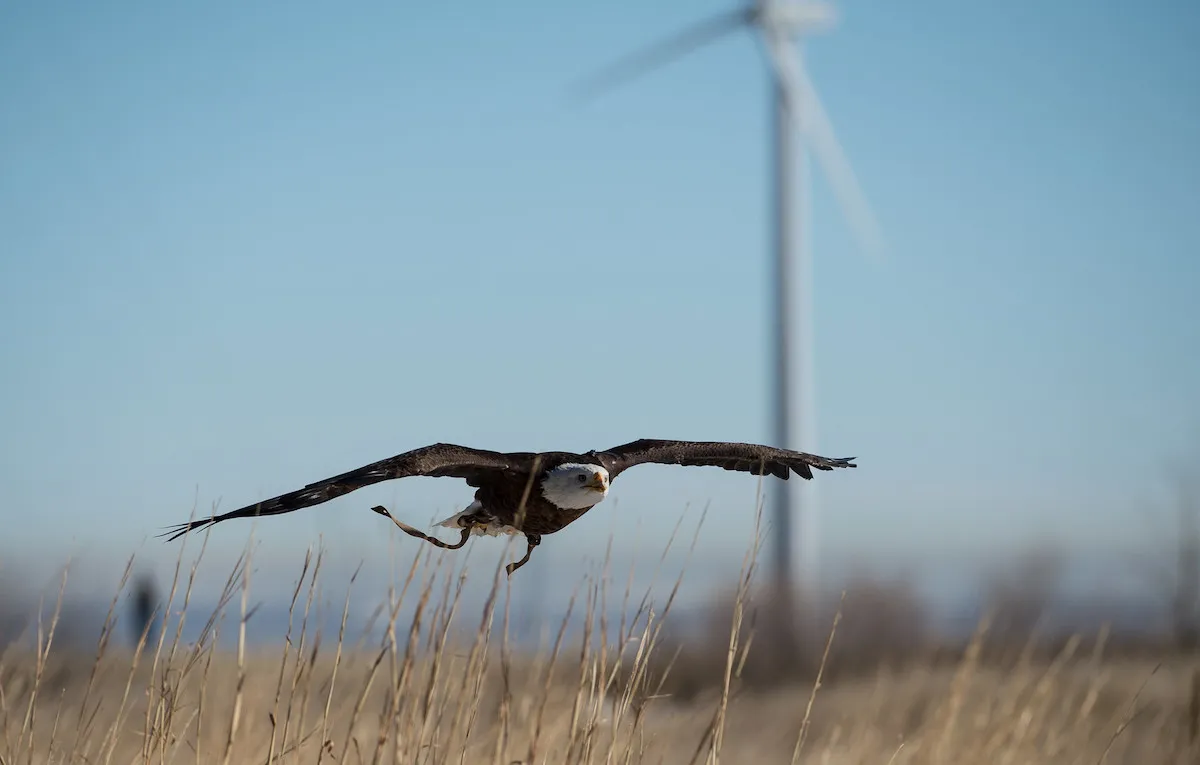- Energy
The energy costs of manufacturing wind turbines are recouped in one to six months; turbines are financially profitable over their lifetimes
Key takeaway
The manufacturing energy costs of wind turbines are recouped within one to six months of operation. The average price for electricity generated by a turbine both covers the turbine's costs and is competitive on the market. While wind turbines are made of materials that can potentially harm the environment, their environmental impact is relatively small compared to fossil fuel facilities. Wind turbines leak 1000 times less oil than oil rigs, on average. The lubricant used by wind turbines can also be recaptured by secondary-containment methods if it leaks. The fiberglass-composite in turbine blades is not biodegradable, so its toxic resin is not released into landfills. Moreover, U.S. turbines are manufactured in many countries around the world, with a significant fraction built in the U.S.
Reviewed content

Verdict:
Claim:
Wind turbines in the US are made of toxic materials that pollute the environment, are mostly built in Germany, and will not pay off their manufacturing costs within their lifetimes.
Verdict detail
Inaccurate: Wind turbines only take one to six months of operation to produce more energy than needed to manufacture and dismantle them. Turbines are typically financially profitable over their lifetimes. The majority of U.S. turbines are built by companies based in the U.S., Denmark, and Spain—not Germany—each with manufacturing facilities in the U.S.
Misleading: Wind turbines leak 1000 times less oil than oil rigs. Although fiberglass-composite wind turbine blades are made of a toxic resin, it isn’t released into the environment when the blade is buried in a landfill.
Full Claim
most of the parts for a wind turbine are built in Germany, it requires 60 gallons of oil to lubricate the turbine; that oil leaks when a seal busts on the ground or into the water. The blades are made of a toxic fiberglass combination and are buried in landfills. The turbine has to spin continuously for 7 plus years just to replace the energy it took to manufacture the turbine. It has to run continually for 50 years just to pay for the cost to manufacture and install the turbine
Dozens of Facebook posts (such as this one or this one posted in March 2021) made multiple misleading claims about the construction, productivity, and impact of wind turbines on the environment, as we describe below. Each of these posts was shared more than 1,000 times on Facebook.
The Money and Energy used to Manufacture Wind Turbines are recouped within their lifetime
The post claims that a turbine “has to spin continuously for 7 plus years just to replace the energy it took to manufacture the turbine”, pointing out that the lifespan of a turbine is about 25 years. The U.S. Energy Information Administration reports that the expected lifespan of a wind turbine is between 20 and 25 years, as claimed in the post[1]. However, according to reliable assessments of wind farm efficiency, the energy costs of manufacturing, installing, dismantling, and disposing of wind turbines are recouped within one and six months of their operation, resulting in up to 24 years of beneficial energy production[2,3,4]. Previous claims about the energy production of wind turbines were evaluated in this Climate Feedback review.
Posts further claim that a turbine “has to run continually for 50 years just to pay for the cost to manufacture and install the turbine.” However, wind turbines are often financially profitable in terms of their manufacturing, installation, and operation costs over their lifetimes[5,6,7,8]. Precisely how long the turbine must run to cover these costs is not easy to express. Because of the massive variability in design, region, competition, energy demands, and desired profit margins, providing a single answer can be misleading. Instead, the electricity industry, private investors, and politicians often use a different way of gauging profitability for any type of electrical production facility, whether fossil fuel or renewable.
A fair way of predicting profitability and comparing energy technologies is to look at the minimum average price that a facility must charge for the electricity it generates in order to cover all manufacturing, installation, and operation costs over its lifetime[5]. The minimum average price is estimated from the data collected by all facilities that have been built. It is expressed as a price per megawatt-hour produced, where a megawatt-hour is a unit of the amount of electricity a generator produces in one hour. If a typical energy company charges more than this price, it ensures a profit, barring unexpected catastrophe. The profit margin is the specific amount the company can charge above this price, and depends heavily on competition. If a rival company has a lower minimum price, it can charge consumers and governments less while obtaining the same profit margin. The rival then has a stronger argument for winning a contract to build its facilities. For this reason, the minimum average price per megawatt is a common standard among those who design and decide upon energy production facilities.
Several analyses of the financial costs of wind turbine production and operation find that an on-shore turbine costs a minimum of $30 to $40 for each megawatt-hour it produces over its lifetime[5,6]. This compares favorably with natural gas, which also costs around $30 to $40 per megawatt-hour produced over its lifetime[5,6]. Because the prices are similar, wind and gas companies can compete for profits. The point at which either type of company pays back its manufacturing, installation, and operating costs still remains variable, since it depends in part on the competition as well as many other environmental and market factors. While at the moment, natural gas and on-shore wind prices are very close, the minimum average price for wind is expected to decrease as the technology matures, which could provide a competitive edge[6].
The Oil Lubricant in a Turbine is a Comparatively Minor Environmental Concern
The amount of oil used to lubricate moving parts in a wind turbine depends on the design, but typically ranges from 20 gallons to 200 gallons[9,10]. The post suggests that if a seal breaks, the lubricant leaks out of the turbine and into the ground or water, implying that this can cause environmental harm. These two aspects of the claim are inaccurate and misleading.
Firstly, the oil lubricating the wind turbine is unlikely to leak into the environment because most of the oil is contained in the turbine’s gearbox[9,11,12]. Although these gearboxes can fail, the vast majority of these failures don’t cause oil leaks or only cause minor leaks[9,11,12]. In fact, only about 2% of gearbox failures are related to the lubrication and filtration systems directly[11]. Even when the turbine’s performance is halted due to a large oil leak, reports find that not all of the gearbox oil leaks out into the ground or water[9]. In fact, because turbines stop functioning correctly when the amount of oil lubricant drops below a certain level, engineers can detect the problem and intervene[9].
More importantly, focusing on potential oil leakages from a single wind turbine might mislead readers regarding the overall environmental impacts of wind farms relative to other energy-production facilities. Since wind turbines use oil, there is always a chance the oil can leak and harm the environment. However, wind farms contribute far less pollution than fossil fuel competitors, including pollution inherent to manufacturing and disposal[2,3,13]. As the technology matures, wind farms can become even cleaner[2,3].
Wind power is often advertised as a “green” energy in comparison to fossil fuels. To understand its benefit over fossil fuels, one could compare how much oil is likely to leak from a typical wind farm and from a typical oil rig. At minimum, an oil well is expected to leak more than a thousand times as much oil on average than a wind farm (about 1,500,000 gallons vs 1,000 gallons over a 30 year period)[10,13][Footnote-1].
Based on the above numbers, the wind farm is much less harmful to the environment than an oil rig in terms of oil leaks, but wind farms also have other advantages. In a wind farm containing 130 turbines and an electrical service platform (containing four transformers), there is an estimated 68,000 gallons of oil. The odds of all this oil spilling due to a catastrophic failure is less than one in a million over a 30 year period[10]. By contrast, an oil well can spill millions of gallons of oil in a day during a “blowout” event[13]. A blowout event is almost five thousand times more likely than the catastrophic failure of the wind farm (slightly less than a one in two-hundred chance over a 30 year period)[13]. The large concentration of oil leaked by a single blowout event at an oil well is much more damaging to the environment than the same amount of oil leaked over a larger period of time, according to assessments[13]. Consequently, even in the worst-case scenario, the wind farm is far less harmful to the environment in terms of the amount of oil leaked.
Furthermore, the wind farm has “secondary containment” methods to catch oil that leaks from its electrical service platform. The effect of secondary containment was not included in the above estimates, so the wind farm is expected to perform even better than quoted. Finally, the lubrication oil in the wind turbine can potentially be replaced by biodegradable and nontoxic lubricants, which are in development[14]. The same cannot happen for an oil rig, which extracts oil from the ground.
The Toxic Resins in the Turbine Blades aren’t released into the ground when they’re buried in landfills
The majority of the wind turbine blades in the U.S. are buried in landfills[15], however, the toxic resin used to create the fiberglass-composite blades is not released into the ground. The resin is used for its durability, therefore it is not biodegradable. Contrary to the post’s claim, the most environmentally harmful effect of burying blades in a landfill is the methane (a nontoxic greenhouse gas) released as the balsa wood frame of the blade biodegrades over hundreds of years. This slow release of methane from the wood is not nearly as harmful to the environment as the use of fossil fuels. In addition, methane recapture methods can be implemented in landfills to mitigate damage to the atmosphere.
Instead of the environmental harm of burying blades in landfills, governments and companies are more concerned with the space the blades occupy in landfills[15]. Due to their durability, turbine blades are difficult to compress into a smaller volume, but disposing of them in landfills is cheap.
To combat space issues in landfills, scientists and engineers are developing and improving methods to recycle blades[16]. The European wind turbine company Vestas already recycles 44% of blades and aims to recycle 55% by 2030[17]. On December 8 2020, GE Renewables, the division of General Electric responsible for U.S. wind turbine production, signed an agreement with Veolia to recycle more than 90% of its onshore wind turbine blades[18]. This process will also prevent methane from being released into landfills.
U.S. Turbines are Built in Many Countries, Including the U.S.
Wind turbines aren’t typically manufactured in Germany. In 2019, three companies were responsible for more than 75% of the wind energy capacity currently available in the U.S.: GE Renewables (based in the U.S.), Vestas (based in Denmark), and Siemens Gamesa (based in Spain)[19,20][Footnote-2]. Each company has manufacturing locations in the U.S. to produce U.S. turbines[21-23]. At least the majority of turbines in the U.S. are produced within the country, providing jobs and economic benefits.
FOOTNOTES
- 1: According to a credible review text, the chance of a blowout in an oil well is about 0.15% per well per year[13]. The average volume of oil leaked during a blowout event depends on the safety measures that were successfully implemented on the rig. For 84% of blowouts, “natural bridging” reduces the average oil leakage to 5.7 million gallons. Natural bridging occurs when naturally occurring solid products in the oil build up and block the site of the oil leak. The process can be encouraged as a safety measure. For 6% of blowouts, “capping and containment” keeps the average oil leakage to about 36 million gallons. Capping and contaminants methods are those that use man-made structures to encapsulate the site of the oil leak. When the aforementioned measures fail in the remaining 10% of blowouts, “relief well drilling” stops the leakage after an average of almost 280 million gallons of oil leaks. A relief well is a separate well that can be dug to intersect the one that is leaking at a location upstream from the leak site. Specialized liquids can then be injected into the relief well to block the flow of oil before the leakage site. Combining estimates for leaks due to these three blowout outcomes, the average amount of oil leaked due to blowout events from a single rig is about 1,500,000 gallons over a 30 year period. Notably, this estimate is only for blowout events. Smaller spills are expected to occur, which pushes the amount of total oil leaked higher. Furthermore, there are other oil-spill events related to oil wells, such as spills on crude oil transport ships. Based on projective modeling, 1,263 gallons of oil are expected to spill over a 30 year period due to failures of the wind farm facility[10]. These failures are due to natural disasters and well as structural issues. The wind farm contains 130 turbines and an electrical service platform. Notably, the electrical service platform has secondary containment to capture oil that spills, so the predicted number is likely an overestimate.
- 2: One can calculate how many U.S. turbines (operational and retired) are created by each company each year, using the raw data publicly available through the U.S. Energy Information Administration[20]. Based on this data, three companies installed about 77% of the turbines in operation in the U.S. as of 2019. These turbines produce almost 80% of the wind energy used in the states[20]. GE is responsible for about 42% of the turbines, Vestas is responsible for about 25% of the turbines, and Siemens is responsible for about 11% of the turbines.
Editor’s Note: This review was updated on 15/4/2021 to add in information on the financial profitability of turbines.
REFERENCES
- 1- Ray (2017) Repowering wind turbines adds generating capacity at existing sites, U.S. Energy Information Administration – EIA – Independent Statistics and Analysis.
- 2- Martínez et al (2009) Life cycle assessment of a multi-megawatt wind turbine, Renewable Energy
- 3 – Uddin et al (2014) Energy, emissions and environmental impact analysis of wind turbine using life cycle assessment technique, Journal of Cleaner Production
- 4 – Hapaala et al (2014) Comparative life cycle assessment of 2.0 MW wind turbines, International Journal of Sustainable Manufacturing
- 5 – (2021) Levelized Costs of New Generation Resources in the Annual Energy Outlook 2021, U.S. Energy Information Administration – EIA – Independent Statistics and Analysis.
- 6 – Wiser et al (2020) Wind Energy Technology Data Update: 2020 Edition, Lawrence Berkeley National Laboratory
- 7 – Stefek et al (2019) Economic Impacts from Wind Energy in Colorado Case Study: Rush Creek Wind Farm, National Renewable Energy Laboratory
- 8 – Krohn et al (2009) The Economics of Wind Energy, European Wind Energy Association
- 9 – Errichello et al (2012) Gearbox Reliability Collaborative Gearbox 1 Failure Analysis Report: December 2010 – January 2011, United States
- 10 – Etkin (2008) Oil spill risk analysis for cape wind energy project, International Oil Spill Conference Proceedings
- 11 – Sheng (2020) Gearbox Reliability Database, National Renewable Energy Laboratory
- 12 – Bhardwaj et al (2019) Reliability prediction of bearings of an offshore wind turbine gearbox, Advances in Renewable Energy Offshore
- 13 – Fingas (2017) Oil Spill Science and Technology, Elsevier Publishing
- 14 – Dvorak (2015) Biodegradable lubricant for hydraulic systems, Windpower Engineering and Development
- 15 – Ramirez-Tejeda (2016) Unsustainable Wind Turbine Blade Disposal Practices in the United States: A Case for Policy Intervention and Technological Innovation, NEW SOLUTIONS: A Journal of Environmental and Occupational Health Policy
- 16 – Jensen et al (2018) Wind turbine blade recycling: Experiences, challenges and possibilities in a circular economy, Renewable and Sustainable Energy Reviews
- 17 – Ekstrand (2020) Zero-waste turbines by 2040, Vestas
- 18 – Veolia (2020) United States: Veolia makes cement and gives a second life to GE Renewable Energy’s wind turbine blades, Veolia Press Release
- 19 – Marcy (2016) Three turbine manufacturers provide more than 75% of U.S. wind capacity, U.S. Energy Information Administration – EIA – Independent Statistics and Analysis.
- 20 – (2020) Form EIA-860 detailed data with previous form data (EIA-860A/860B), U.S. Energy Information Administration – EIA – Independent Statistics and Analysis.
- 21 – (2021) GE RENEWABLE ENERGY LOCATIONS, General Electric Renewable Energy
- 22 – (2021) Vestas Locations around the world, Vestas
- 23 – (2021) Location Finder, Siemens Gamesa Renewable Energy



